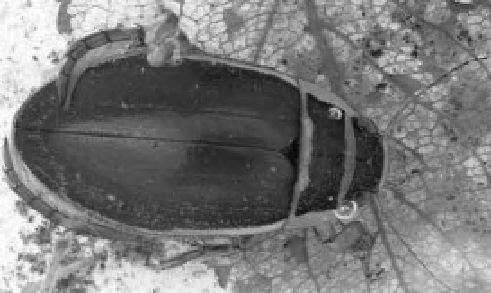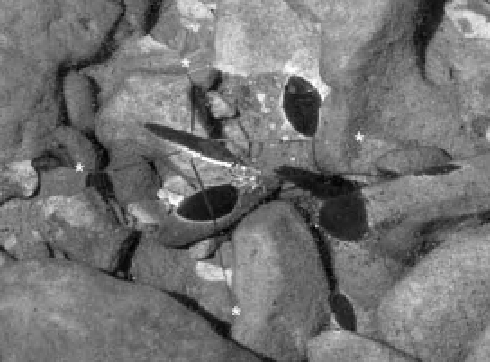Geoscience Reference
In-Depth Information
Figure 7-3.
Great diving beetle (
Dytiscus marginalis
).
Note the feather-like legs for swimming; body is about
one inch (25 mm) long. Modii ed from original
photograph by H. Gröschl; obtained from Wikimedia
Commons
<
http://commons.wikimedia.org/
>
.
Figure 7-4.
Water strider (
Gerris remigis
) on a shallow
clear stream. Distortions on water show where the legs
have depressed the surface tension (*) and refracted
sunlight creating the dark spots on gravel bed. Photo
by J.S. Aber and S.W. Aber; Kahola Creek, Kansas,
United States.
which they cope may change substantially as
they undergo metamorphosis in life stages.
Insects breathe with a system of internal air
tubes, known as tracheae that connect to every
cell in the body (Salsbury and White 2000). Those
that live under water must obtain oxygen in some
way. In their larval stage, many aquatic insects,
including mosquitos, have tiny abdominal tubes
that act like snorkels so the larvae can breathe
air directly (Dugan 2005). Other aquatic nymphs,
such as mayl ies and damsell ies, breathe with
tracheal gills on the abdomen. Some insect
larvae, such as caddisl ies (
Limnephilus
sp.),
absorb oxygen directly from water through thin
portions of their outer body casing, known as
the cuticle. The great diving beetle (
Dytiscus
marginalis
) breathes from bubbles of air trapped
under its wings before each hunting dive.
Swimming insects have natatorial legs, which
are l attened, laterally extended, and often have
rows of tiny hairs so they resemble feathers (Fig.
7-3). The legs function like oars or paddles, so
the insect may swim powerfully and gracefully
under water. Another group of insects inhabits
the surface tension. Whirligig beetles (family
Gyrinidae) move rapidly in large groups half in
and half out of the water. Each compound eye
is divided in half to view above and below water
at the same time. Water striders (family Gerri-
dae), also known as pond skaters, have long
slender legs. Fine unwettable hairs on the tarsal
segments support the strider on the water
surface (Fig. 7-4). Both of these groups scavenge
for insects and other animals trapped on the
surface tension.
Damsell ies and dragonl ies (suborder Ani-
soptera) are among the most spectacular of aerial
wetland insects. The immature nymphs live
under water for one to three years, where they
undergo 10-15 instar stages in which they molt
their skin and grow larger each time. They are
ferocious predators using a hinged and hooked
lower lip to capture insects, especially mosquito
larvae, and other small animals (Beckemeyer and
Huggins 1997, 1998). As adults, damsell ies are
delicate creatures and fold their wings upward
together, when resting, but dragonl y wings
remain i xed out to the sides (Fig. 7-5A & B).
Dragonl ies are among the strongest insect
l yers, reaching speeds up to 30 km/h, and they
have huge eyes for tracking prey. They have
extreme maneuverability, including hovering
and even l ying backward. The common green
darner exhibits a distinctive color change that
depends on temperature. At low temperature,
the abdomen is a dark red-purple color, which
changes to bright blue at higher temperature
(Fig. 7-5C). This blue is thought to rel ect most
solar radiation in order to limit overheating
during the day. Conversely the darker color
absorbs solar energy to warm up the body






